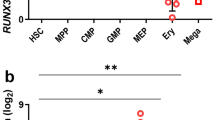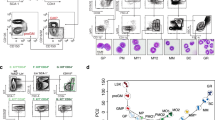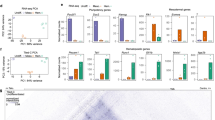Abstract
Aberrant expression of the human homeobox-containing proto-oncogene TLX1/HOX11 inhibits hematopoietic differentiation programs in a number of murine model systems. Here, we report the establishment of a murine erythroid progenitor cell line, iEBHX1S-4, developmentally arrested by regulatable TLX1 expression. Extinction of TLX1 expression released the iEBHX1S-4 differentiation block, allowing erythropoietin-dependent acquisition of erythroid markers and hemoglobin synthesis. Coordinated activation of erythroid transcriptional networks integrated by the acetyltransferase co-activator CREB-binding protein (CBP) was suggested by bioinformatic analysis of the upstream regulatory regions of several conditionally induced iEBHX1S-4 gene sets. In accord with this notion, CBP-associated acetylation of GATA-1, an essential regulator of erythroid differentiation, increased concomitantly with TLX1 downregulation. Coimmunoprecipitation experiments and glutathione-S-transferase pull-down assays revealed that TLX1 directly binds to CBP, and confocal laser microscopy demonstrated that the two proteins partially colocalize at intranuclear sites in iEBHX1S-4 cells. Notably, the distribution of CBP in conditionally blocked iEBHX1S-4 cells partially overlapped with chromatin marked by a repressive histone methylation pattern, and downregulation of TLX1 coincided with exit of CBP from these heterochromatic regions. Thus, we propose that TLX1-mediated differentiation arrest may be achieved in part through a mechanism that involves redirection of CBP and/or its sequestration in repressive chromatin domains.
This is a preview of subscription content, access via your institution
Access options
Subscribe to this journal
Receive 50 print issues and online access
$259.00 per year
only $5.18 per issue
Buy this article
- Purchase on Springer Link
- Instant access to full article PDF
Prices may be subject to local taxes which are calculated during checkout




Similar content being viewed by others
Accession codes
References
Ait-Si-Ali S, Polesskaya A, Filleur S, Ferreira R, Duquet A, Robin P et al. (2000). CBP/p300 histone acetyl-transferase activity is important for the G1/S trasnsition. Oncogene 19: 2430–2437.
Akimov SS, Ramezani A, Hawley TS, Hawley RG . (2005). Bypass of senescence, immortalization, and transformation of human hematopoietic progenitor cells. Stem Cells 23: 1423–1433.
Allen TD, Zhu Y-X, Hawley TS, Hawley RG . (2000). TALE homeoproteins as HOX11-interacting partners in T-cell leukemia. Leuk Lymphoma 39: 241–256.
Bayly R, Chuen L, Currie RA, Hyndman BD, Casselman R, Blobel GA et al. (2004). E2A-PBX1 interacts directly with the KIX domain of CBP/p300 in the induction of proliferation in primary hematopoietic cells. J Biol Chem 279: 55362–55371.
Berger LC, Hawley RG . (1997). Interferon-β interrupts interleukin-6-dependent signaling events in myeloma cells. Blood 89: 261–271.
Blobel GA . (2000). CREB-binding protein and p300: molecular integrators of hematopoietic transcription. Blood 95: 745–755.
Blobel GA, Nakajima T, Eckner R, Montminy M, Orkin SH . (1998). CREB-binding protein cooperates with transcription factor GATA-1 and is required for erythroid differentiation. Proc Natl Acad Sci USA 95: 2061–2066.
Choi Y, Elagib KE, Delehanty LL, Goldfarb AN . (2006). Erythroid inhibition by the leukemic fusion AML1-ETO is associated with impaired acetylation of the major erythroid transcription factor GATA-1. Cancer Res 66: 2990–2996.
Chrivia JC, Kwok RP, Lamb N, Hagiwara M, Montminy MR, Goodman RH . (1993). Phosphorylated CREB binds specifically to the nuclear protein CBP. Nature 365: 855–859.
Dear TN, Sanchez-Garcia I, Rabbitts TH . (1993). The HOX11 gene encodes a DNA-binding nuclear transcription factor belonging to a distinct family of homeobox genes. Proc Natl Acad Sci USA 90: 4431–4435.
Deguchi K, Ayton PM, Carapeti M, Kutok JL, Snyder CS, Williams IR et al. (2003). MOZ-TIF2-induced acute myeloid leukemia requires the MOZ nucleosome binding motif and TIF2-mediated recruitment of CBP. Cancer Cell 3: 259–271.
Greene WK, Bahn S, Masson N, Rabbitts TH . (1998). The T-cell oncogenic protein HOX11 activates Aldh1 expression in NIH 3T3 cells but represses its expression in mouse spleen development. Mol Cell Biol 18: 7030–7037.
Guenatri M, Bailly D, Maison C, Almouzni G . (2004). Mouse centric and pericentric satellite repeats form distinct functional heterochromatin. J Cell Biol 166: 493–505.
Hawley RG, Fong AZC, Lu M, Hawley TS . (1994). The HOX11 homeobox-containing gene of human leukemia immortalizes murine hematopoietic precursors. Oncogene 9: 1–12.
Hawley RG, Fong AZC, Reis MD, Zhang N, Lu M, Hawley TS . (1997). Transforming function of the HOX11/TCL3 homeobox gene. Cancer Res 57: 337–345.
Heidari M, Rice KL, Phillips JK, Kees UR, Greene WK . (2006). The nuclear oncoprotein TLX1/HOX11 associates with pericentromeric satellite 2 DNA in leukemic T-cells. Leukemia 20: 304–312.
Helt AM, Galloway DA . (2003). Mechanisms by which DNA tumor virus oncoproteins target the Rb family of pocket proteins. Carcinogenesis 24: 159–169.
Herblot S, Steff AM, Hugo P, Aplan PD, Hoang T . (2000). SCL and LMO1 alter thymocyte differentiation: inhibition of E2A-HEB function and pre-Tα chain expression. Nat Immunol 1: 138–144.
Hernandez-Hernandez A, Ray P, Litos G, Ciro M, Ottolenghi S, Beug H et al. (2006). Acetylation and MAPK phosphorylation cooperate to regulate the degradation of active GATA-1. EMBO J 25: 3264–3274.
Hong W, Kim AY, Ky S, Rakowski C, Seo SB, Chakravarti D et al. (2002). Inhibition of CBP-mediated protein acetylation by the Ets family oncoprotein PU 1. Mol Cell Biol 22: 3729–3743.
Huang S, Qiu Y, Stein RW, Brandt SJ . (1999). p300 functions as a transcriptional coactivator for the TAL1/SCL oncoprotein. Oncogene 18: 4958–4967.
Hung HL, Lau J, Kim AY, Weiss MJ, Blobel GA . (1999). CREB-binding protein acetylates hematopoietic transcription factor GATA-1 at functionally important sites. Mol Cell Biol 19: 3496–3505.
Iyer NG, Ozdag H, Caldas C . (2004). p300/CBP and cancer. Oncogene 23: 4225–4231.
Kamps MP, Wright DD . (1994). Oncoprotein E2A-Pbx1 immortalizes a myeloid progenitor in primary marrow cultures without abrogating its factor-dependence. Oncogene 9: 3159–3166.
Kang-Decker N, Tong C, Boussouar F, Baker DJ, Xu W, Leontovich AA et al. (2004). Loss of CBP causes T cell lymphomagenesis in synergy with p27Kip1 insufficiency. Cancer Cell 5: 177–189.
Karuppayil SM, Moran E, Das GM . (1998). Differential regulation of p53-dependent and -independent proliferating cell nuclear antigen gene transcription by 12 S E1A oncoprotein requires CBP. J Biol Chem 273: 17303–17306.
Kasper LH, Fukuyama T, Biesen MA, Boussouar F, Tong C, de Pauw A et al. (2006). Conditional knockout mice reveal distinct functions for the global transcriptional coactivators CBP and p300 in T-cell development. Mol Cell Biol 26: 789–809.
Kawabe T, Muslin AJ, Korsmeyer SJ . (1997). HOX11 interacts with protein phosphatases PP2A and PP1 and disrupts a G2/M cell-cycle checkpoint. Nature 385: 454–458.
Keller G, Wall C, Fong AZC, Hawley TS, Hawley RG . (1998). Overexpression of HOX11 leads to the immortalization of embryonic precursors with both primitive and definitive hematopoietic potential. Blood 92: 877–887.
Kostic C, Shaw PH . (2000). Isolation and characterization of sixteen novel p53 response genes. Oncogene 19: 3978–3987.
Krasnoselskaya-Riz I, Spruill A, Chen YW, Schuster D, Teslovich T, Baker C et al. (2002). Nuclear factor 90 mediates activation of the cellular antiviral expression cascade. AIDS Res Hum Retroviruses 18: 591–604.
Kung AL, Rebel VI, Bronson RT, Ch'ng LE, Sieff CA, Livingston DM et al. (2000). Gene dose-dependent control of hematopoiesis and hematologic tumor suppression by CBP. Genes Dev 14: 272–277.
Kwok RP, Lundblad JR, Chrivia JC, Richards JP, Bachinger HP, Brennan RG et al. (1994). Nuclear protein CBP is a coactivator for the transcription factor CREB. Nature 370: 223–226.
Kyba M, Perlingeiro RCR, Daley GQ . (2002). HoxB4 confers definitive lymphoid-myeloid engraftment potential on embryonic stem cell and yolk sac hematopoietic precursors. Cell 109: 29–37.
Lahlil R, Lecuyer E, Herblot S, Hoang T . (2004). SCL assembles a multifactorial complex that determines glycophorin A expression. Mol Cell Biol 24: 1439–1452.
Larson RC, Osada H, Larson TA, Lavenir I, Rabbitts TH . (1995). The oncogenic LIM protein Rbtn2 causes thymic developmental aberrations that precede malignancy in transgenic mice. Oncogene 11: 853–862.
Owens BM, Hawley RG . (2002). HOX and non-HOX homeobox genes in leukemic hematopoiesis. Stem Cells 20: 364–379.
Owens BM, Hawley TS, Spain LM, Kerkel KA, Hawley RG . (2006). TLX1/HOX11-mediated disruption of primary thymocyte differentiation prior to the CD4+CD8+ double-positive stage. Br J Haematol 132: 216–229.
Owens BM, Zhu YX, Suen TC, Wang PX, Greenblatt JF, Goss PE et al. (2003). Specific homeodomain-DNA interactions are required for HOX11-mediated transformation. Blood 101: 4966–4974.
Popratiloff A, Giaume C, Peusner KD . (2003). Developmental change in expression and subcellular localization of two shaker-related potassium channel proteins (Kv1.1 and Kv1.2) in the chick tangential vestibular nucleus. J Comp Neurol 461: 466–482.
Riz I, Hawley RG . (2005). G1/S transcriptional networks modulated by the HOX11/TLX1 oncogene of T-cell acute lymphoblastic leukemia. Oncogene 24: 5561–5575.
Rodriguez P, Bonte E, Krijgsveld J, Kolodziej KE, Guyot B, Heck AJ et al. (2005). GATA-1 forms distinct activating and repressive complexes in erythroid cells. EMBO J 24: 2354–2366.
Schaufele F, Enwright III JF, Wang X, Teoh C, Srihari R, Erickson R et al. (2001). CCAAT/enhancer binding protein α assembles essential cooperating factors in common subnuclear domains. Mol Endocrinol 15: 1665–1676.
Schuh AH, Tipping AJ, Clark AJ, Hamlett I, Guyot B, Iborra FJ et al. (2005). ETO-2 associates with SCL in erythroid cells and megakaryocytes and provides repressor functions in erythropoiesis. Mol Cell Biol 25: 10235–10250.
Shen WF, Krishnan K, Lawrence HJ, Largman C . (2001). The HOX homeodomain proteins block CBP histone acetyltransferase activity. Mol Cell Biol 21: 7509–7522.
Soulier J, Clappier E, Cayuela JM, Regnault A, Garcia-Peydro M, Dombret H et al. (2005). HOXA genes are included in genetic and biologic networks defining human acute T-cell leukemia (T-ALL). Blood 106: 274–286.
Sykes DB, Kamps MP . (2001). Estrogen-dependent E2a/Pbx1 myeloid cell lines exhibit conditional differentiation that can be arrested by other leukemic oncoproteins. Blood 98: 2308–2318.
Wadman IA, Osada H, Grutz GG, Agulnick AD, Westphal H, Forster A et al. (1997). The LIM-only protein Lmo2 is a bridging molecule assembling an erythroid, DNA-binding complex which includes the TAL1, E47, GATA-1 and Ldb1/NLI proteins. EMBO J 16: 3145–3157.
Watamoto K, Towatari M, Ozawa Y, Miyata Y, Okamoto M, Abe A et al. (2003). Altered interaction of HDAC5 with GATA-1 during MEL cell differentiation. Oncogene 22: 9176–9184.
Wen J, Huang S, Pack SD, Yu X, Brandt SJ, Noguchi CT . (2005). Tal1/SCL binding to pericentromeric DNA represses transcription. J Biol Chem 280: 12956–12966.
Wu R, Terry AV, Singh PB, Gilbert DM . (2005). Differential subnuclear localization and replication timing of histone H3 lysine 9 methylation states. Mol Biol Cell 16: 2872–2881.
Yang LV, Nicholson RH, Kaplan J, Galy A, Li L . (2001). Hemogen is a novel nuclear factor specifically expressed in mouse hematopoietic development and its human homologue EDAG maps to chromosome 9q22, a region containing breakpoints of hematological neoplasms. Mech Dev 104: 105–111.
Yang XJ . (2004). Lysine acetylation and the bromodomain: a new partnership for signaling. BioEssays 26: 1076–1087.
Yoshida M, Nomura S, Beppu T . (1987). Effects of trichostatins on differentiation of murine erythroleukemia cells. Cancer Res 47: 3688–3691.
Zhang N, Shen W, Hawley RG, Lu M . (1999). HOX11 interacts with CTF1 and mediates hematopoietic precursor cell immortalization. Oncogene 18: 2273–2279.
Author information
Authors and Affiliations
Corresponding author
Additional information
Supplementary Information accompanies the paper on the Oncogene website (http://www.nature.com/onc).
Supplementary information
Rights and permissions
About this article
Cite this article
Riz, I., Akimov, S., Eaker, S. et al. TLX1/HOX11-induced hematopoietic differentiation blockade. Oncogene 26, 4115–4123 (2007). https://doi.org/10.1038/sj.onc.1210185
Received:
Revised:
Accepted:
Published:
Issue Date:
DOI: https://doi.org/10.1038/sj.onc.1210185
Keywords
This article is cited by
-
NKL homeobox genes in leukemia
Leukemia (2012)
-
TLX1 and NOTCH coregulate transcription in T cell acute lymphoblastic leukemia cells
Molecular Cancer (2010)



